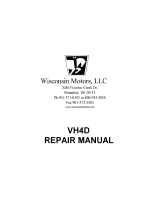
CONTENTS
Section Title Page
...........................................
1
.
SPECIFICATIONS
1
2
.
PERFORMANCE
...........................................
2
2-1 Maximum Output
........................................
2
2-2 Continuous Rated Output
..................................
2
2-3
Maximum Torque and Fuel Consumption Ratio
at
Max
.
Output
.........
2
3
.
FEATURES
................................................
4
4
.
GENERAL DESCRIPTION
of
ENGINE CONSTRUCTION
...............
4
4-1
Cylinder Crankcase
......................................
4
4-2 Main Bearing Cover
.......................................
4
4-3 Crankshaft
...........................................
4
4-5 Camshaft
.............................................
4
4-7 Cylinder Head
..........................................
5
4-8 Governor
.............................................
5
4-9 Cooling
...............................................
5
4-10
Lubrication
............................................
5
4-11 Ignition
..............................................
5
4-13 Air Cleaner
............................................
5
4-14 Sectional View
of
Engine
...................................
6
4.4 Connecting Rod and Piston
.................................
4
4-6 Valve Arrangement
.......................................
5
4-12 Carburetor
............................................
5
5.lNSTALLATlON
............................................
14
5-1 Installing
..............................................
14
5-2 Ventilation
............................................
14
5-3 Exhaust Gas Evacuation
....................................
14
5-4
Fuel System
...........................................
14
5-5 Power Transmission to Driven Machines
.........................
14
5-6
Wiring
.............................................
15
6
.
DISASSEMBLY
and
REASSEMBLY
..............................
21
6-1 Preparation and Suggestions
.................................
21
6-2 Special Tools
...........................................
21
6-3
Disassembly and Ressembly Procedures
.........................
22























